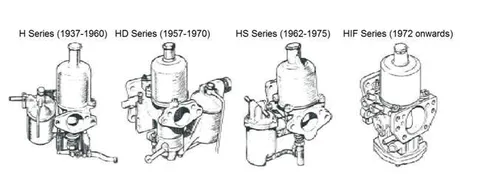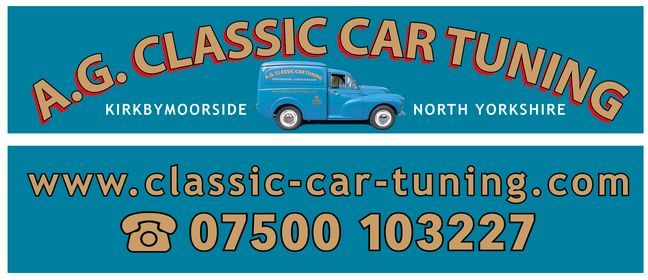So what happens when you book a 'tune up' for your car?
The first stage is for you to send me some details about your, and the location where you would like me to tune the car?
- Make, Model, Year, significant modifications
- Perhaps send me a picture or two from under the bonnet showing the engine ID, Carbs (Carb ID tags if possible) and Distributor
- Your location - Hull, York, Leeds, Whitby etc etc
I'll then give you an 'indication' of the price inclusive of my travel to give your car a tune up. There is always some 'flexibility' with this price because your car could be a extremely well maintained show winner which is easy to work on. Or...it could be a car which hasn't seen so much love over the years which then requires a lot of other little jobs, niggles and issues sorting before it can be tuned. Any pictures sent earlier can help me get a basic understanding of the expected condition nice and early.
So, we agree a time date and location and we start to plan your tune up session.
In each case I have the same simple request to please make sure....(SEE PAGE - PREPARING FOR A TUNE UP)
- The car is nicely topped up with engine oil and coolant.
- Has some nice fresh petrol in the tank > 2 Gallon is always good!
- The battery has a good healthy charge, and connected.
- The car is available to be worked on in a safe and well ventilated location.
- Also.....that you make sure to mention any other mechanical/engine related issues which may be present.
What happens in the Day?
The day starts with a little mutual respect of what I am there to do, and likewise a recognition of what I'm not there to do.
What I am there to do?........I'm there to take a look over all the key factors involved, and then tune your car......No complicated explanation required.
What I'm NOT there to do?
This sounds more obvious to some than it may be to others, and the 'give an inch, take a mile' saying. But....for clarity I'm there only to health check and tune the car.
- I'm not there to be pinned in a corner and asked 1001 questions about your car, or to give a 1 on 1 training course on how to tune classic cars.
-----------------------------------------------------------------------------------------------------------------
On the day what to expect?
So the day day comes and I arrive at your chosen location. Hopefully we have a nice 'cuppa' and you tell me a little about the recent running of your car. I then take a look over the critical areas which will allow me to tune your car. Areas such as battery connections, earth straps, fuelling pipes to the carbs and general other aspects of good order and housekeeping on the car. Hopefully your car is 'fit and healthy' enough to be tuned, and hence not asking me to bring it back to life from some drastic and more severe issues.
I then start by taking some readings of your existing state of tune, including carbs, ignition, alternator charge, coil resistance and other general notes.
I then take a look over the carbs and record all key values and components which will effect the car on fast idle (choke), and also at normal idle, plus general running. In the process I'll also correct any issues to a correct ball park figure of what they should be. Pending final adjustments.
I'll then take a look over your ignition timing and adjust it to the correct setting for your car, in accordance with the specification or very close to original factory values with an allowance for modern fuel and some historical 'wear and tear' of the vehicle. Likewise for points gaps and resultant dwell angles.
I will then return to your carbs, and do a little fine tuning, balancing and adjusting to the correct values now as appropriate to the correct ignition timing, and mechanical advance curve.
Take it for a spin and tell me what you think?
Once everything is checked and double checked I may then ask you as the owner to take your car for a spin and on return let me have your feedback.
Hopefully you're a happy customer and drive back with a smile on your face!
Spares for a tuning session
Throughout the above process I do carry a few 'odds and sods' of typical spares. However, it's not possible for me to have one of everything for every classic car carb and dizzy ever made. So if you don't know when the plugs were last changed, buy some new ones in advance of my visit. I'll happily gap them correctly and install them. Likewise for points and condensers, electronic ignition modules, dizzy caps, rotors, carb needles etc.
Afterwards........enjoy driving your classic car, and feeling it run, start and perform the way it was designed to.
A Classic Mini Before Tuning.......(listen to the tone, regularity, pitch of the exhaust note. Then compare with the second video taken of the same car and hour or two later.)
The Same Classic Mini, mid way through a tuning session. Again listen to the tone, regularity, and pitch of the exhaust tone in comparison to the prior video.
Working Mobile.....or best done in my garage?
If the work is just a case of balancing carbs, setting up mixtures, baselining choke setting and of course optimising ignition timing, I can usually do it all on a mobile basis.
However.....sometimes the job 'is' or becomes a bit bigger than first meets the eye or the client really knows. In which case the only viable option can be for the car to be brought to my garage to be looked at. Let me explain this a bit further by giving a couple of examples.
Example A - The E-Type Jaguar V12.
There were two key areas for which this client needed my support. The first of which was to fully baseline and synch all 4 carburettors together, both on choke and for normal operation. The second was to help optimise and set up cold starts. As you can imagine, I can only simulate a cold start once, or maybe twice in a single day because once it has run then there will always be some residual heat held in the engine. After setting up the cold start to the best I can, the proving ground is then another cold start the following day. Hence it makes sense for the car to be in my garage, ready for that early morning start so I can check all is well and inform the client that the car is ready for collection.
Example B - The leaking float bowls
From time to time you will here classic car owners talk about 'sticking needle valves'. These in brief are the shut off mechanism used in many classic carbs to ensure that the carb only receives as much fuel as it can handle. Once it reaches this limit a float mechanism lifts, and the needle value closed off the inlet to the carb preventing further fuel from being added. However, when needle valves stick it its usually in an open position meaning that excess fuel enters the float bowl an needle to somehow spill out.
On some carbs such as the SU, H, HD HS models the float bowl is at the side of the carb and it is relatively easy to remove and replace the needle valve without having to remove the carb from the engine. However in carbs such as the HIF version of the SU, or Zenith Stromberg CD the float mechanism is inconveniently located below the body of the carb. Realistically the only practical way to remove a sticking needle valve ad replace with a new needle valve, is to remove the carb and carry out the work on a suitable surface or work bench. In which case......I would normally suggest that either the carb is sent to me to do this work. Or.....the required work on this car is done in my garage, so that I have a good light source, clean work bench, a fire extinguisher to hand and also a few spares kicking around if needed. It's often not practical and also not without risk for this to be done in the average home garage.

Example C - The faulty parts
We don't live in a perfect world and there will always be parts which are ready for the bin from the very moment that they are taken out of the brand new packaging. The quality of parts now supplied from certain areas of the world doesn't seem to face the same quality tests and scrutiny which may have taken place when your classic was built. It is really unfortunate when this occurs, however from a logistics and practicality point of view if you've brought your car to my garage, and left it with me, it helps to avoid the awkward situation of a second set of mobilisation costs for me to travel out to your location with the time and travel costs involved.
Example D - The fuel tank full of sediment
There have been occasions where I have been out to tune a vehicle which had intermittent running problems. To describe the symptoms reported by the owner, basically some days it would run ok, and others not. Some days it would run for 10 mins before cutting out, and some days not run at all. There are many potential component failures which can give these type of symptoms, an additional potential cause can however there can also be such as fuel starvation due to a blockage somewhere in the fuel line or carburation. Rectifying such problems when working on a mobile becomes more of a mechanical maintenance task than a 'tuning' task. For example, at times the only remedy is to remove the fuel tank and clean it thoroughly. Perhaps the entire fuel lines need cleaning, and backwashing too. Perhaps the carburettor float mechanism needs cleaning together with Jets unblocking using carb cleaner and compressed air. Again these type of tasks are best done in a garage environment for safety reasons, practicality and also to use additional resources such as a compressed air supply......all more suited to a garage than a mobile visit.
